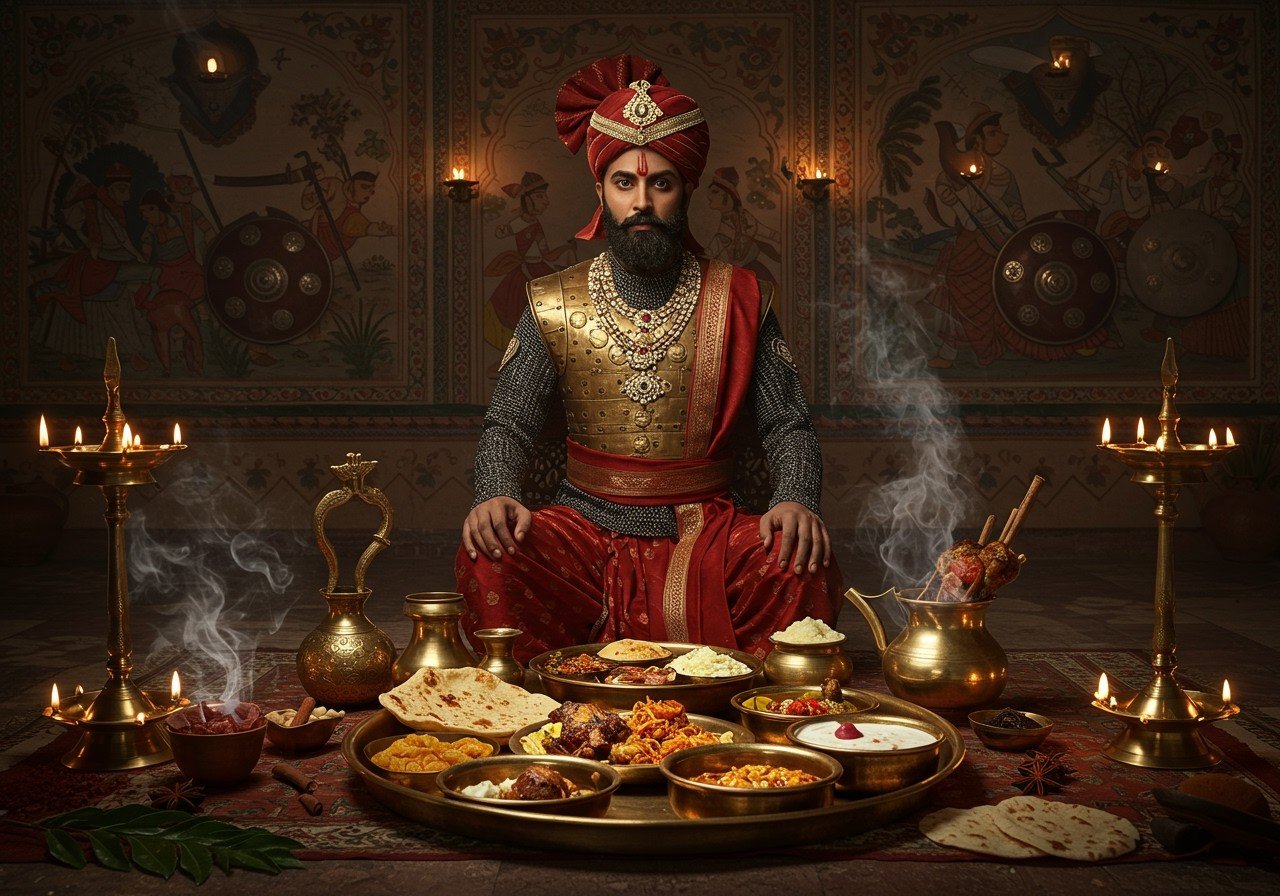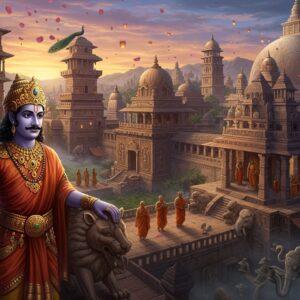
The Kshatriya community, deeply rooted in India’s ancient history, is renowned for its warrior ethos and rich cultural heritage. Their vibrant traditions, from culinary practices to attire and performing arts, shape their identity even today. This blog delves into the fascinating world of Kshatriya cuisine, dress, and performing arts, offering a glimpse into their enduring legacy.
Kshatriya Foods: A Warrior’s Table – History and Traditions
Kshatriya cuisine, known for its robust flavors and hearty dishes, mirrors the community’s strength and valor. Historically, meat, especially game, played a significant role, symbolizing strength and valor. The use of spices and herbs is integral to Kshatriya cooking, adding depth and complexity to their meals. From everyday meals to ceremonial feasts during festivals and rituals, food holds a special cultural significance, varying across regions with unique local ingredients and techniques.
Traditional cooking methods, such as open-flame grilling and slow cooking in earthen pots, enhance the flavors of Kshatriya dishes. The term ‘Shikar‘ (hunting) is deeply intertwined with their culinary heritage. Communal feasting, a cornerstone of Kshatriya culture, strengthens bonds of unity and camaraderie.
Explore the sacred relationship between food and divinity in Hinduism on poojn.in.
Kshatriya Dress: Symbols of Nobility and Valor
Kshatriya attire reflects their noble warrior status. Traditional garments like the ‘Angarkha‘ and ‘Churidar‘ for men carry historical weight, often crafted from luxurious silk and brocade, showcasing the community’s royal lineage. Jewelry and turbans aren’t mere accessories; they are potent symbols of rank and valor within Kshatriya society.
Over time, Kshatriya costumes have evolved, blending traditional elements with modern fashion trends. Terms like ‘Pagri‘ (turban) and ‘Kada‘ (bracelet) remain integral components of their attire. Women’s clothing, with its elegant sarees and lehengas, displays distinct gendered aesthetics. Ceremonial attire for weddings and religious functions adds another layer of cultural significance.
Find traditional attire and accessories on poojn.in to enhance your cultural celebrations.
Kshatriya Dance: Expressions of Martial Prowess and Cultural Heritage
Kshatriya dance forms are a captivating blend of martial prowess and cultural expression. The ‘Chhau‘ dance, a traditional martial art form, showcases agility, strength, and storytelling through movement. Ceremonial dances performed during festivals embody spiritual and cultural narratives, while regional influences enrich Kshatriya dance with local elements.
Music, featuring instruments like drums and flutes, elevates the dance experience. ‘Nritya‘ (dance) and ‘Naatya‘ (drama) are inseparable from Kshatriya performing arts. Dance serves as a powerful medium, narrating historical events and mythical tales, passing down traditions through generations. Preservation efforts are vital to safeguarding these vibrant art forms.
Historical Context of Kshatriya Cuisine
Kshatriya food traditions, shaped by regional ingredients, customs, and historical events, have evolved over time. Meat has historically held a significant place in their diet, a reflection of their warrior lifestyle. In ancient times, it provided the strength and sustenance needed for warfare, with hunting being an integral part of life, not just for food but also to refine martial skills.
However, vegetarianism also played a role, particularly during peacetime or for religious observances. This balance between non-vegetarian and vegetarian practices showcases the adaptability and richness of Kshatriya culinary traditions.
Regional Variations and Specific Communities
Kshatriya cuisine is diverse, varying significantly across different regions and specific communities. Here are a few examples:
Somvanshi Kshatriya Pathare (SKP) Cuisine
Hailing from Maharashtra, the SKP community enjoys a cuisine that artfully combines vegetables, eggs, fish, and meat, with a particular fondness for seafood. Their signature SKP Masala, a unique spice blend, adds a distinct flavor to their dishes, which include the flavorful Ukad Handi, similar to the more widely known Undhiyu. The SKP community’s culinary traditions reflect the coastal influence and their diverse palate.
Bhavsar Kshatriya Cuisine
Spread across Gujarat, Maharashtra, Rajasthan, and other states, the Bhavsar community demonstrates a wide range of culinary preferences. Some members adhere to vegetarian diets, while others relish dishes featuring chicken, fish, or lamb. This culinary diversity reflects the community’s adaptability and regional influences.
Lodh Kshatriya Cuisine
The Lodh Kshatriya community prides itself on a rich culinary heritage, boasting regional delicacies and unique cooking practices. Their traditions showcase a deep connection to their roots, passed down through generations, preserving the distinct flavors of their ancestors. The Lodh culinary practices are a testament to their cultural richness.
Chandraseniya Kayastha Prabhu (CKP) Cuisine
A sub-caste of the Kshatriya community, the CKPs have developed a cuisine that blends Maharashtrian influences with their origins in Kashmir and North India, further shaped by their coastal settlements along the Konkan coast. Their dishes often feature ingredients like bitter beans, dried prawns, and dried shrimps, showcasing the fusion of diverse culinary traditions. Their unique culinary style is a reflection of their historical journey and regional influences.
Key Aspects of Kshatriya Cuisine
Kshatriya cuisine is characterized by its emphasis on robust flavors and the strategic use of ingredients. Meat, often acquired through hunting or ritual sacrifices, historically formed a significant part of their diet. Aromatic spices, skillfully blended, lend depth and complexity to their dishes. Dairy products, including milk, ghee, butter, and curd, are also essential components, enriching their meals with both flavor and nutritional value.
Beverages also play a role in Kshatriya culinary traditions. Intoxicating liquors such as “Sura,” made from fermented barley or wild paddy, were historically consumed, complementing their meals and reflecting their cultural practices. The variations in food habits within the Kshatriya community are a testament to the interplay of family traditions, regional influences, and personal preferences, creating a vibrant tapestry of culinary heritage.
How Poojn Supports Kshatriya Traditions
Poojn.in, India’s largest Dashakarma Bhandar, is dedicated to providing authentic and high-quality products that support Kshatriya customs and rituals. We offer a comprehensive range of items essential for traditional ceremonies and practices:
- Holy Utensils:
From traditional copper and brass vessels to special plates and bowls designed for ceremonial meals, we offer a wide selection of utensils to maintain the sanctity of your rituals.
Our ritual-specific serving dishes ensure that every aspect of your ceremonies adheres to tradition.
- Holy Food Items:
We source pure ghee for sacred offerings, along with traditional spices and ingredients essential for preparing authentic Kshatriya dishes.
Our selection of ceremonial food items caters to specific ritualistic needs.
- Puja Samagri:
Our complete puja kits are tailored for Kshatriya ceremonies, containing all the necessary sacred items for warrior clan rituals.
We also offer traditional incense and dhoop to create a sacred ambiance.
- Dashakarma Items:
We provide full ceremonial kits for important life events, including custom-packaged ritual materials and quality-checked traditional items, ensuring that every detail is taken care of.
Our commitment to quality ensures that your ceremonies are conducted with utmost authenticity.
To order these items for your Kshatriya ceremonies, please visit www.poojn.in or contact us:
- Phone: 03369029784
- WhatsApp: 9476142738
All our products are carefully selected and packaged to maintain ritual purity. We deliver across India, bringing the convenience of online shopping to your doorstep, ensuring that you have access to authentic ceremonial items wherever you are.
Celebrating Kshatriya Culinary Heritage
Kshatriya cuisine is a vibrant tapestry woven with history, tradition, and the unique flavors of diverse communities. It embodies the warrior spirit with hearty meat dishes while also encompassing the balance of vegetarian offerings. Each region and community contributes its own distinctive touch, resulting in a rich mosaic of tastes and culinary practices.
From the coastal delicacies of the CKPs to the aromatic spice blends of the SKPs, each dish tells a story of valor, adaptability, and cultural heritage. The skillful use of spices and adherence to traditional rituals further enhances the dining experience, making every meal a celebration of Kshatriya legacy.
Today, the convenience of online shopping brings authentic ingredients and recipes directly to our homes, allowing us to honor these traditions while enjoying the ease of modern life. By embracing both the old and the new, we keep the warrior’s table alive, connecting with our roots in a meaningful way.
Explore the diverse world of Kshatriya cuisine and embark on a culinary journey rich in history and flavor. Savor the dishes, appreciate the traditions, and let your taste buds dance to the rhythm of a heritage that bridges the past and the present.
FAQs on Kshatriya Cuisine and Culture
What are some traditional Kshatriya foods? Traditional Kshatriya cuisine often features hearty and flavorful dishes, such as meat curries, biryanis, and kebabs. These dishes often incorporate a rich blend of spices, reflecting the bold and vibrant nature of the Kshatriya community. Many regional variations exist, with each community adding its unique touch to the culinary landscape.
How is Kshatriya dress unique? Kshatriya dress is known for its regal and elegant style, often incorporating luxurious fabrics like silk and brocade. Men traditionally wear attire like dhotis or kurta-pajamas, while women wear intricately designed sarees. These garments often feature elaborate embroidery and embellishments, symbolizing their royal heritage and status.
What kind of dance is associated with Kshatriya culture? Various dance forms are associated with Kshatriya culture, with each region having its unique styles. Kathak, a classical dance form, is renowned for its intricate footwork and expressive hand gestures, often narrating stories of valor and courage. Other regional dances reflect the martial traditions and cultural nuances of specific Kshatriya communities.
Why is food important in Kshatriya culture? Food plays a central role in Kshatriya culture, symbolizing hospitality, community, and celebration. Meals are often grand affairs, bringing people together to share not only food but also stories and traditions. The act of sharing a meal reinforces bonds and strengthens the sense of belonging within the community.
How has Kshatriya cuisine evolved over time? Kshatriya cuisine has evolved over centuries, influenced by regional variations, cultural exchanges, and historical events. While traditional dishes continue to hold a special place, the cuisine has also adapted to incorporate new ingredients and cooking techniques. This evolution reflects the dynamic nature of culture and the adaptability of the Kshatriya community.
What festivals are celebrated in Kshatriya culture? Kshatriyas celebrate major Indian festivals like Diwali, Dussehra, and Holi with great enthusiasm. These celebrations are marked by vibrant traditions, including elaborate feasts, traditional music performances, and energetic dances. Each festival carries unique significance, reinforcing cultural values and strengthening community bonds.
How do rituals and traditions influence Kshatriya cuisine? Rituals and traditions are deeply intertwined with Kshatriya cuisine. Many dishes are specifically prepared for festivals or ceremonies, carrying symbolic meaning and reflecting the community’s values and history. These culinary traditions serve as a powerful link to the past, preserving cultural heritage and passing it down through generations. Specific ingredients, cooking methods, and serving practices are often dictated by ritualistic guidelines.


